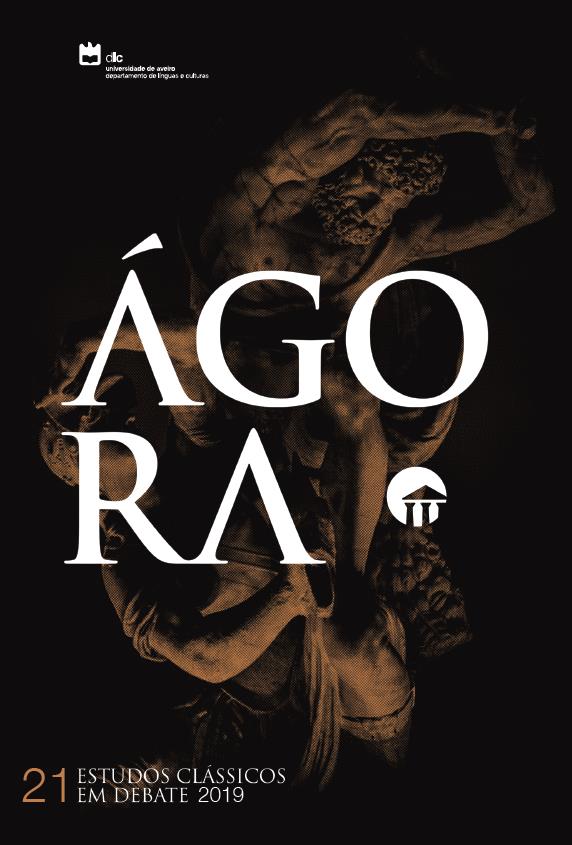La figura del “antisenado” (ἀντισύγκλητος) en Plutarco: ¿una narrativa del declive?
Palavras-chave:
Plutarco, Sulpício, narrativas de declínio, transgressão
Resumo
No ano 88 a. C., a entrada em vigor da legislação de Públio Sulpício Rufo implicou o início de um período de transição sem precedentes do sistema republicano. Plutarco de Queroneia apresenta duas passagens (Mar. 35; Sull. 8) em que os seus seguidores são definidos com o nome de ‘antisenado’ (ἀντισύγκλητος). É nosso propósito verificar a veracidade desta afirmação, mostrando até que ponto ela faz parte ou não de um constructo narrativo, típico de declínio, utilizada pelo biógrafo para analisar um momento-chave no que diz respeito à transgressão.
Downloads
Dados de Download não estão ainda disponíveis.
Referências
ABE, T. (2017), “Introduction to Part II: Ancient Construction of Decline-Narratives”: T. MINAMIKAWA (ed.), Decline and Decline-narratives in the Greek and Roman World. Kyoto, 43-44.
ARENA, V. (2010), “Mos maiorum”: M. BEVIR (ed.), Encyclopedia of Political Theory 1. Berkeley, 40-41.
ARENA, V. (2015), “Informal Norms, Values, and Social Control in the Roman Participatory Context”: D. HAMMER (ed.) (2015), A Companion to Greek Democracy and the Roman Republic. Cambridge, 217-238.
BABEAU, O. (2007), Le Manager et la Transgression Ordinaire des Regles: le cas des societes de conseil en management. Gestion et management. París.
BADIAN, E. (1958), Foreign Clientelae, 264-70 B.C. Oxford.
BADIAN, E. 1969, “Quaestiones Variae”: Historia 18 (1969) 447-491.
BISPHAM, E. (2011), “Time for Italy in Velleius Paterculus”: E. COWAN (ed.), Velleius Paterculus. Swansea.
BISPHAM, E. (2016), “The Civil Wars and the Triumvirate”: A. E. COOLEY (ed.), A Companion to Roman Italy. Oxford, 90-102.
CARNEY, T. F. (1960), “Plutarch’s Style in the Marius”: Journal of Hellenic Studies 80 (1960) 24-31.
CARNEY, T. F. (1970), A Biography of C. Marius. Chicago.
CHAPMAN, C. (1979), “Cicero and Sulpicius Rufus (tr.pl. 88 B.C.)”: Acta Classica 22 (1979) 194-204.
DE SANCTIS, G. (1976), La Guerra Sociale. Firenze.
DUPLÁ, A. (2007), “Interpretaciones de la crisis tardorrepublicana: del conflicto social a la articulación del consenso”: Studia historica 25 (2007) 185-201.
EVANS, R. J. (1994), Gaius Marius: a Political Biography. University of South Africa.
GALBRAITH, C. (2005), The Language of Popular Politics from the Gracchi to Sulla. University of St. Andrews.
GOLDEN, G. K. (2013), Crisis Management during the Roman Republic: the Role of Political Institutions in Emergencies. Cambridge.
HEREDIA, C. (2015a), “Problemáticas metodológicas en el análisis de la violencia y el miedo a raíz de la Guerra Social (91-87 a.C.)”: M. OLAYA, et alii (eds.), II Jornadas Predoctorales en Estudios de la Antigüedad y la Edad Media. Londres, 65-71.
HEREDIA, C. (2015b), “El impacto de la Guerra Social en el bienio 88-87 a.C.: miedo y violencia como motores de transgression”: Clio & Crimen. Revista del Centro de Historia del Crimen de Durango 12 (2015) 251-276.
HINARD, F. (1985), Sylla. Paris.
HÖLKESKAMP, K-J. (2010), Reconstructing the Roman Republic: an Ancient Political Culture and Modern Research. Princeton.
HURLET, F. (2017), “La dualité du consulat à l’épreuve de la longue duréé. À propos de la transgression et du contournement de la norme”: T. ITGENSHORST; P. LE DOZE (eds.), Les normes sous la République et le Haut-Empire romains. Élaboration, diffusion et contournements. Bordeaux, 283-299.
KATZ, B. R. (1976), “Studies in the period of Cinna and Sulla”: AC 45 (1976) 497-549.
KEAVENEY, A. (1983), What Happened in 88?: Eirene 20 (1983) 55-86.
KELLY, G.P., 2006, A History of Exile in the Roman Republic. Cambridge.
KENDALL, S. (2013), The Struggle for Roman Citizenship. Romans, Allies, and the Wars of 91-77 BCE. Piscataway.
KUNKEL, W. (1972), “Magistratische Gewalt und Senatscherrschaft”: ANRW 1.2 (1972) 3-22.
LEE STECUM, P. (2014), “Roman Elite Ethnicity”: J. MCINERNEY (ed.), Ethnicity in the Ancient Mediterranean. Oxford, 455-469.
LEWIS, R.G. (1998), “P. Sulpicius’ Law to Recall Exiles, 88 B.C.”: CQ 48 (1998) 195-199.
LINTOTT, A. W. (1968), Violence in Republican Rome. Oxford.
LINTOTT, A. W. (1971): “The Tribunate of P. Sulpicius Rufus”: CQ 21.2 (1971) 442-453.
LOVANO, M. (2002): The Age of Cinna. Sttutgart.
LUNDGREEN, C. (2017), “Norme, loi, règle, coutume, tradition: terminologie antique et perspectives modernes”: T. ITGENSHORST; P. LE DOZE (eds.), Les normes sous la République et le Haut-Empire romains. Élaboration, diffusion et contournements. Bordeaux, 17-33.
LUTZ, B.; LUTZ, J. (2006), “Political Violence in the Republic of Rome: Nothing New under the Sun”: Government and Opposition 41.4 (2006) 491-511.
MEIER, C. (1980), Res publica amissa. Wiesbaden.
MITCHELL, T. N. (1975), “The Volte-Face of P. Sulpicius Rufus in 88 B.C.”: CPh 70 (1975) 197-204.
MORSTEIN, R. (2011), “Consular appeals to the army in 88 and 87: the locus of legitimacy in late-republican Rome”: H. BECK et alii (eds.), Consuls and Res Publica. Holding High Office in the Roman Republic. Cambridge.
MURONI, A. (2013) “Ciuitas Romana: emersione di una categoria nel diritto e nella politca tra Regnum e Res Publica”: Diritto Storia 12 (2013) 1-19.
NIPPEL, W. (1984), “Policing Rome”: JRS 74 (1984) 20-9.
NIPPEL, W. (1995), Public Order in Ancient Rome. Cambridge.
PEDRONI, L. (2006), Crisi finanziaria e monetazione durante la Guerra Sociale. Bruxelles.
PERRY, E. (2015), “Art, Architecture, and Space in the Roman Participatory Context”: D. HAMMER (ed.), A Companion to Greek Democracy and the Roman Republic. Cambridge, 482-500.
POWELL, J. G. F. (1990), “The Tribune Sulpicius”: Historia 39 (1990) 446-460.
RAMBAUD, M. (1953), Cicéron et l’histoire romaine. Paris.
SANCHO, A. (1985), Apiano. Guerras Civiles. Madrid.
SALMON, E.T. (1958), “Notes on the Social War”: TAPhA 89 (1958) 159-179.
SIMÓN, F. M. (2011), “The Feriae Latinae as Religious Legitimation of the Consuls’ imperium”: H. BECK et alii (eds.), Consuls and Res Publica. Cambridge, 116-132.
SMITH, C. (2012), “Feriae Latinae”: J. BRANDT; W. IDDENG (eds.), Greek and Roman Festival: Content, Meaning and Practice. Oxford, 267-288.
STEEL, C. (2013), The End of the Roman Republic, 146 to 44 B.C. Conquest and Crisis. Edimburgh.
STONE, A. M. (2002), “Pro and anti: the dignitas of the senate in 88 BC”: P. MCKECHNIE (ed.), Thinking like a lawyer. Essays on legal history and general history for J. Crook on his eightieth birthday. Leiden, Boston, Köln, 191-212.
STRAUMANN, B. (2016), Crisis and Constitutionalism: Roman Political Thought from the Fall of the Republic to the Age of Revolution. Oxford.
VALGIGLIO, E. (1954), Vita di Silla. Turino.
VAN DER BLOM, H. (2010), Cicero’s role models. The Political Strategy of a Newcomer. Oxford.
YAKOBSON, A. (2014), “Marius Speaks to the People: “New Man”, Roman Nobility and Roman Political Culture”: Scripta Classica Israelica 33 (2014) 283-300.
ARENA, V. (2010), “Mos maiorum”: M. BEVIR (ed.), Encyclopedia of Political Theory 1. Berkeley, 40-41.
ARENA, V. (2015), “Informal Norms, Values, and Social Control in the Roman Participatory Context”: D. HAMMER (ed.) (2015), A Companion to Greek Democracy and the Roman Republic. Cambridge, 217-238.
BABEAU, O. (2007), Le Manager et la Transgression Ordinaire des Regles: le cas des societes de conseil en management. Gestion et management. París.
BADIAN, E. (1958), Foreign Clientelae, 264-70 B.C. Oxford.
BADIAN, E. 1969, “Quaestiones Variae”: Historia 18 (1969) 447-491.
BISPHAM, E. (2011), “Time for Italy in Velleius Paterculus”: E. COWAN (ed.), Velleius Paterculus. Swansea.
BISPHAM, E. (2016), “The Civil Wars and the Triumvirate”: A. E. COOLEY (ed.), A Companion to Roman Italy. Oxford, 90-102.
CARNEY, T. F. (1960), “Plutarch’s Style in the Marius”: Journal of Hellenic Studies 80 (1960) 24-31.
CARNEY, T. F. (1970), A Biography of C. Marius. Chicago.
CHAPMAN, C. (1979), “Cicero and Sulpicius Rufus (tr.pl. 88 B.C.)”: Acta Classica 22 (1979) 194-204.
DE SANCTIS, G. (1976), La Guerra Sociale. Firenze.
DUPLÁ, A. (2007), “Interpretaciones de la crisis tardorrepublicana: del conflicto social a la articulación del consenso”: Studia historica 25 (2007) 185-201.
EVANS, R. J. (1994), Gaius Marius: a Political Biography. University of South Africa.
GALBRAITH, C. (2005), The Language of Popular Politics from the Gracchi to Sulla. University of St. Andrews.
GOLDEN, G. K. (2013), Crisis Management during the Roman Republic: the Role of Political Institutions in Emergencies. Cambridge.
HEREDIA, C. (2015a), “Problemáticas metodológicas en el análisis de la violencia y el miedo a raíz de la Guerra Social (91-87 a.C.)”: M. OLAYA, et alii (eds.), II Jornadas Predoctorales en Estudios de la Antigüedad y la Edad Media. Londres, 65-71.
HEREDIA, C. (2015b), “El impacto de la Guerra Social en el bienio 88-87 a.C.: miedo y violencia como motores de transgression”: Clio & Crimen. Revista del Centro de Historia del Crimen de Durango 12 (2015) 251-276.
HINARD, F. (1985), Sylla. Paris.
HÖLKESKAMP, K-J. (2010), Reconstructing the Roman Republic: an Ancient Political Culture and Modern Research. Princeton.
HURLET, F. (2017), “La dualité du consulat à l’épreuve de la longue duréé. À propos de la transgression et du contournement de la norme”: T. ITGENSHORST; P. LE DOZE (eds.), Les normes sous la République et le Haut-Empire romains. Élaboration, diffusion et contournements. Bordeaux, 283-299.
KATZ, B. R. (1976), “Studies in the period of Cinna and Sulla”: AC 45 (1976) 497-549.
KEAVENEY, A. (1983), What Happened in 88?: Eirene 20 (1983) 55-86.
KELLY, G.P., 2006, A History of Exile in the Roman Republic. Cambridge.
KENDALL, S. (2013), The Struggle for Roman Citizenship. Romans, Allies, and the Wars of 91-77 BCE. Piscataway.
KUNKEL, W. (1972), “Magistratische Gewalt und Senatscherrschaft”: ANRW 1.2 (1972) 3-22.
LEE STECUM, P. (2014), “Roman Elite Ethnicity”: J. MCINERNEY (ed.), Ethnicity in the Ancient Mediterranean. Oxford, 455-469.
LEWIS, R.G. (1998), “P. Sulpicius’ Law to Recall Exiles, 88 B.C.”: CQ 48 (1998) 195-199.
LINTOTT, A. W. (1968), Violence in Republican Rome. Oxford.
LINTOTT, A. W. (1971): “The Tribunate of P. Sulpicius Rufus”: CQ 21.2 (1971) 442-453.
LOVANO, M. (2002): The Age of Cinna. Sttutgart.
LUNDGREEN, C. (2017), “Norme, loi, règle, coutume, tradition: terminologie antique et perspectives modernes”: T. ITGENSHORST; P. LE DOZE (eds.), Les normes sous la République et le Haut-Empire romains. Élaboration, diffusion et contournements. Bordeaux, 17-33.
LUTZ, B.; LUTZ, J. (2006), “Political Violence in the Republic of Rome: Nothing New under the Sun”: Government and Opposition 41.4 (2006) 491-511.
MEIER, C. (1980), Res publica amissa. Wiesbaden.
MITCHELL, T. N. (1975), “The Volte-Face of P. Sulpicius Rufus in 88 B.C.”: CPh 70 (1975) 197-204.
MORSTEIN, R. (2011), “Consular appeals to the army in 88 and 87: the locus of legitimacy in late-republican Rome”: H. BECK et alii (eds.), Consuls and Res Publica. Holding High Office in the Roman Republic. Cambridge.
MURONI, A. (2013) “Ciuitas Romana: emersione di una categoria nel diritto e nella politca tra Regnum e Res Publica”: Diritto Storia 12 (2013) 1-19.
NIPPEL, W. (1984), “Policing Rome”: JRS 74 (1984) 20-9.
NIPPEL, W. (1995), Public Order in Ancient Rome. Cambridge.
PEDRONI, L. (2006), Crisi finanziaria e monetazione durante la Guerra Sociale. Bruxelles.
PERRY, E. (2015), “Art, Architecture, and Space in the Roman Participatory Context”: D. HAMMER (ed.), A Companion to Greek Democracy and the Roman Republic. Cambridge, 482-500.
POWELL, J. G. F. (1990), “The Tribune Sulpicius”: Historia 39 (1990) 446-460.
RAMBAUD, M. (1953), Cicéron et l’histoire romaine. Paris.
SANCHO, A. (1985), Apiano. Guerras Civiles. Madrid.
SALMON, E.T. (1958), “Notes on the Social War”: TAPhA 89 (1958) 159-179.
SIMÓN, F. M. (2011), “The Feriae Latinae as Religious Legitimation of the Consuls’ imperium”: H. BECK et alii (eds.), Consuls and Res Publica. Cambridge, 116-132.
SMITH, C. (2012), “Feriae Latinae”: J. BRANDT; W. IDDENG (eds.), Greek and Roman Festival: Content, Meaning and Practice. Oxford, 267-288.
STEEL, C. (2013), The End of the Roman Republic, 146 to 44 B.C. Conquest and Crisis. Edimburgh.
STONE, A. M. (2002), “Pro and anti: the dignitas of the senate in 88 BC”: P. MCKECHNIE (ed.), Thinking like a lawyer. Essays on legal history and general history for J. Crook on his eightieth birthday. Leiden, Boston, Köln, 191-212.
STRAUMANN, B. (2016), Crisis and Constitutionalism: Roman Political Thought from the Fall of the Republic to the Age of Revolution. Oxford.
VALGIGLIO, E. (1954), Vita di Silla. Turino.
VAN DER BLOM, H. (2010), Cicero’s role models. The Political Strategy of a Newcomer. Oxford.
YAKOBSON, A. (2014), “Marius Speaks to the People: “New Man”, Roman Nobility and Roman Political Culture”: Scripta Classica Israelica 33 (2014) 283-300.
Publicado
2019-04-01
Secção
Artigos










